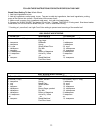
15
KNEAD After the dough has risen, it is then stirred down briefly by the knead bar to remove excess carbon dioxide
gas created by the yeast.
SPECIAL NOTE:
• If using the DOUGH setting, its cycle is complete at this time and ready for hand shaping , rising and
baking in your own oven. An audible alert will sound and the bread maker will turn itself off after
completion of the DOUGH cycle.
RISE The dough is then allowed to rise again, but for a shorter period of time.
KNEAD After the shorter rise time, the dough is again stirred down by the knead bar to remove excess gas and also to
shape the dough into a ball for the final rise. This final knead ensures that the bread will have good texture.
RISE The dough then goes into the final rise to achieve its maximum height. Again, you may hear faint clicking
sounds during the rise as gentle heat is provided to keep the chamber warm.
BAKE The bread is then baked. An audible alert will sound when the bread is done and green Keep Warm light will
glow. When the bread is removed, turn bread maker off by holding down the START/STOP button until
Keep Warm light goes out, about 3 seconds.
TROUBLESHOOTING GUIDE
Following are some typical problems that can occur when making bread in your bread maker. Please review the problems,
their possible causes and the corrective action that should be taken to ensure successful bread making.
PROBLEM POSSIBLE CAUSE SOLUTION
1. Top inflated, Too much yeast. Reduce yeast by ¼ to ½ teaspoon.
mushroom-like
in appearance Too much sugar. Reduce sugar by 1 teaspoon.
Too much flour. Reduce flour by 2 to 3 tablespoons.
Substituted bread machine/ Use correct amount of bread machine/fast
fast-rising yeast for amount machine/fast rising yeast.
given for active dry yeast.
Not enough salt. Use amount of salt recommended in recipe.
Warm, humid weather. Reduce liquid by 1 tablespoon and reduce yeast by ¼
to ½ teaspoon.
May be caused from Make recommended adjustment for high altitude
baking in high altitude. baking by reducing yeast by ¼ teaspoon and reducing
liquid by 2 to 3 teaspoons.
2. Top and sides Too much liquid. Reduce liquid by 1 tablespoon.
cave in.
Too much yeast. Use amount recommended in recipe.
3. Center of loaf is Too much liquid. Reduce liquid by 1 tablespoon.
raw, not baked
through. Power outage during If power goes out during operation bread maker will be
turned off automatically. You will need to remove
unbaked loaf from pan and start over with fresh
ingredients.
Forgot to put knead Always make sure knead bar is on shaft in bottom of
bar in pan. pan before adding ingredients.


















